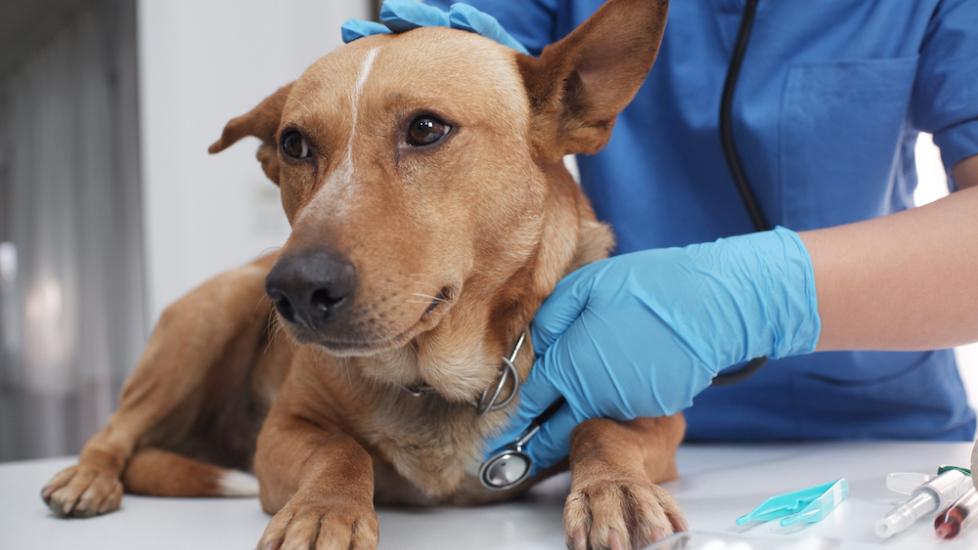Clotting Disorders of the Platelets in Dogs
What Are Clotting Disorders of the Platelets in Dogs?
Clotting disorders in dogs are any type of disease that results in a dog’s blood not being able to clot properly. Blood clotting disorders, or coagulopathies, are a broad category and can be due to issues either with platelets or with the substances in blood known as clotting factors.
Platelets are cell fragments in circulating blood. Platelets are the first responders to stop any type of bleeding and start clot formation. Clot formation, or the plugging of any tiny areas of tissue hemorrhage, occurs constantly in a dog’s body even if no major injury or trauma has occurred. A certain number of platelets are needed in order to be able to clot, and the platelets need to be healthy.
A lack of platelets, known as thrombocytopenia, can cause problems with blood clotting. A thrombocytopathy occurs if platelets in the blood are not healthy enough to perform their function.
Types of Clotting Disorders of the Platelets in Dogs
There are two main types of thrombocytopathies:
1) Hereditary thrombocytopathies: These are genetic and passed down from generation to generation in certain lines of dogs.
2) Acquired thrombocytopathies: These are rare and occur secondary to a toxin or infection.
Symptoms of Clotting Disorders of the Platelets in Dogs
Clinical signs of thrombocytopathies in dogs include:
-
Nosebleeds
-
Bleeding from the gums or gingiva
-
Tiny bruises under the skin, known as petechia
-
Blood in the urine or feces
-
Bleeding excessively from cuts or wounds
Causes of Clotting Disorders of the Platelets in Dogs
Causes of of inherited thrombocytopathies, including the breed or breeds where the cause is commonly diagnosed include:
-
Canine Scott syndrome (CSS): German Shepherd
-
Bleeding occurs after injury–platelets can form normally but cannot organize into a clot.
-
-
CalDAG-GEFI deficiency: Basset Hound, Spitz
-
Bleeding occurs after injury and a dog’s platelets are unable to form normally.
-
-
Glanzmann’s thrombasthenia: Otterhound, Great Pyrenees
-
Bleeding occurs because the platelets do not have enough of a certain protein required for them to bridge together and form a clot.
-
-
P2Y12 receptor mutation: Greater Swiss Mountain Dog
-
Dogs carrying this mutation are unable to aggregate their platelets.
-
Causes of acquired thrombocytopathies include:
-
Rare complications from infections such as leptospirosis, ehrlichiosis
-
Complications from severe liver or kidney disease
How Veterinarians Diagnose Clotting Disorders of the Platelets in Dogs
A variety of tests are used for the diagnosis of thrombocytopathies in dogs including:
-
A complete blood count (CBC) calculates the numbers of the types of blood cells circulating in the blood, including red blood cells, white blood cells, and platelets.
-
Manual platelet count and cytology checks for the number of platelets, evaluates their size and shape and if they are aggregating (clumping together).
-
A chemistry panel evaluates liver, kidney, blood-sugar, and protein levels in the bloodstream, to diagnose the health of the organs.
-
Prothrombin time (PT) and partial thromboplastin time (PTT) tests measure how quickly the blood clots and checks to make sure that other parts of the clotting system, not related to platelets, are functioning.
-
The buccal mucosa bleeding time (BMBT) test directly checks how quickly the platelets can stop bleeding. A precise, superficial cut is made on the dog’s gum and the response is carefully measured.
-
Von Willebrand factor assay checks for von Willebrand deficiency in dogs that are at risk for having inherited this disease.
-
Genetic testing to determine carriers of inherited traits can be performed so that dogs known to have a propensity to develop the disease are not bred.
Treatment of Clotting Disorders of the Platelets in Dogs
Treatment of thrombocytopathies in dogs varies, depending on the type and require a veterinarian.
Inherited thrombocytopathies: For dogs with the inherited clotting disorder, surgery should be avoided. If trauma or an unavoidable surgery occurs, these dogs may be treated with cryoprecipitate (plasma-derived blood product) transfusions or injections of the medication desmopressin. These treatments are designed to stop bleeding in the short term. There is no permanent cure for thrombocytopathies at this time.
Acquired thrombocytopathies: For these dogs, the underlying cause must be treated.
In cases of thrombocytopathies causing severe bleeding, transfusions of red blood cells or platelets may be needed.
Recovery and Management of Clotting Disorders of the Platelets in Dogs
Successful management of this condition depends greatly on the underlying cause, and the individual pet’s response to therapies. Your veterinarian will work with you to determine the best treatment plan based on your dog’s medical history.
Spontaneous bleeding is possible at any time with an active thrombocytopathy. If bleeding occurs in your dog, keep it as quiet as possible and avoid any rigorous exercise or play. Crate rest is recommended and, for some dogs, sedatives may be helpful. Monitor your pet for any signs of bleeding, especially around the nose or mouth. Check for any areas where small bruises may be forming. The easiest areas to see bruising are on the inside of the ear flap and on your dog’s abdomen, where the hair is more sparse.
If your pet gets a wound or cut, keep him as calm as possible and apply gentle pressure for 4 to 5 minutes and contact a veterinarian. If bleeding from the nose or mouth does not stop after 10 minutes, contact a veterinarian.
Featured Image: iStock.com/Supitnan Pimpisarn
Help us make PetMD better
Was this article helpful?
